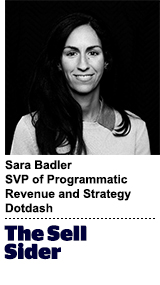
“The Sell Sider” is a column written by the sell side of the digital media community.
Today’s column is written by Sara Badler, senior vice president of programmatic revenue and strategy at Dotdash.
While programmatic buying strategies and buzzwords du jour change, one fact remains constant: Every impression counts.
The buyer emphasis on achieving the best possible campaign performance at the lowest possible rate remains. For a long time, buyers gravitated toward deals – preferred deals , private auctions, programmatic guaranteed – while ignoring the value of the occasionally wild west-esque open market.
That may have led to some successful campaigns, but publishers need to help buyers consider the bigger picture.
For example, when crafting a programmatic strategy, many buyers tend not to consider “backfill” ads, which are unsold, usually low-value ads that most or all partners have declined to purchase. But these impressions can be used and monetized in unique and innovative ways, such as bringing in additional passback partners or running house ads in those slots.
When trying to optimize the open market, publishers must educate buyers about these types of opportunities.
Into the open
Marketers should look to the open exchange for certain campaigns – and publishers should encourage this. If a very low CPM is all an advertiser wants, by all means, they should buy through the open market.
Buyers and sellers must realize that the open market and programmatic direct deals are constantly evolving. Publishers need to analyze the purchasing patterns of their buyers closely, looking at bid density, win rates across supply sources and seasonal trends.
One way that publishers can optimize for every impression is through thoughtful and savvy price flooring. Editorial teams should constantly look at site analytics and traffic patterns to inform their publishing decisions. The revenue side of the business needs to use this same data to inform their price flooring. Flooring by day of week, time of day, ad unit and content area should all be considered and can all have significant impact on overall eCPM. The beginning of the year and the summer are times of notoriously low demand, so flooring should be adjusted to accompany those lulls in the market.
In addition to optimizing for current open market patterns, it is a publisher’s job to seek and provide private marketplace (PMP) opportunities that make sense for buyers’ KPIs. There are enough advertisers out there looking for premium, high-performing inventory at scale to book a full suite of PMP business across verticals. These PMPs then perform the magic of actually lifting the open market CPM, improving yield across the board.
Partner considerations
In addition to each deal type, there are also benefits and drawbacks to working with specific demand-side platforms (DSPs) and supply-side platforms (SSPs). Publishers need to know if SSPs or DSPs have individual relationships and commitments with certain platforms and agencies, so they can surface the best options and opportunities for a buyer.
There are also a wide and varied group of demand partners that can be added into a publisher’s stack and tested on an ad hoc basis. Some of these partners have specific niches and areas of strength – verticalization, specialty geos, etc. – and can be integrated and monitored if publishers need help in a specific problem area or region. Also, integration via Amazon’s Transparent Ad Marketplace on the server side and other header-bidding partners can be quick and easy, so turning partners on and off is not the resource and time-intensive task that it once was.
It is important for publishers to talk to their advertisers to find out which ways and through which platforms they want to buy. It is often across multiple platforms and deal types, and it is important to capture spend from all of those buckets.
Both buyers and sellers alike should analyze their digital ad strategy holistically – analyzing every impression and operating in all worlds to maximize ROI. Each deal type, including the open exchange, has its place, and it is up to marketers to decide which deal type is best for each of their campaigns.
Advertisers’ buying patterns, in addition to outside forces such as GDPR, bid shading and changes in auction types, need to be taken into consideration when publishers look at the health of their ad stack and ad spend.
Follow Dotdash (@dotdashco) and AdExchanger (@adexchanger) on Twitter.
This post was syndicated from Ad Exchanger.


More Stories
Comic: The Curated Marketplace
INMA Global Media Awards: NZME wins Best Use of Print
Zillow Offers Some Reassurances About Moving After Emotional Bluey Episode